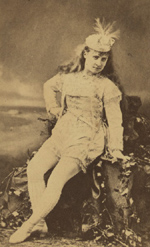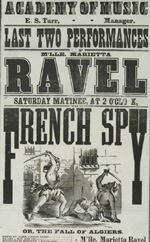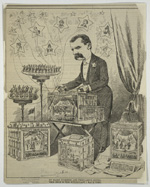The New York
Public Library for the Performing Arts > Vaudeville
Nation
19th Century Roots
 19th century
Lydia Thompson
19th century
Lydia Thompson
in her costume for Ixion
"Portraits of Celebrities,
New H Series"
Billy Rose Theatre Collection
 Broadside for Marietta Ravel's
Broadside for Marietta Ravel's
productions of The French Spy
and The Wizard Skiff, 1866.
 Cartoon of Haverly
Cartoon of Haverly
toy theaters
Unidentified
newspaper, April 12, 1879
Billy Rose Theatre Collection
The Variety traditions in 19th century America
In the mid-19th century, performers in the European popular and
street theater traditions frequently toured North and Central America. The
mixed bills included rope dancing, pantomime, dance, and acrobatics,
often performed by members of extended families, such as the Ravels.
Combinations
Combinations were variety bills compiled by a name brand manager
and promoted by him/them. Stetson and the pantomime team of Maffitt
and Bartholomew were performers; Haverly was a theater owner and
producer who recognized the importance of the railroad in planning
tours.
Museums
Associated with P. T. Barnum, museums, dime museums and eden
musées were a transition form that combined live variety shows
with passive viewing of artifacts. These broadsides and correspondence
concern appearances by Al Fostell, a "Dutch" comic in museums and
vaudeville, who also had a male/female song and dance act.
Minstrelsy and Burlesque
The typical Minstrel show was a variety bill in 3 sections. The
first was a concert of "Plantation songs," ranging from spirituals
to works by Stephan C. Foster, Dan Emmett, James Bland or others. The
second section was one or more specific parodies of a play, opera
or ballet that was known to the audience. These productions, with
titles such as "Ill True Bad-Doer," involved female impersonation
and blackface make-up. The third section, also in blackface, was
a semi-circle of musicians in identical costumes trading songs and
jokes through the stock characters, Mr. Bones, Mr. Tambo and Mr.
Interlocutor. Vaudeville replaced minstrel shows in professional
theater, but a combination of the first and third sections remained
popular in amateur and fund-raising performance for decades. In
addition, many figures in theater and popular entertainment retained
nostalgia for minstrelsy, so the semi-circle form with blackface
was often revived in production numbers.
In the 19th century, Burlesques were popular entertainments that
combined specific parodies with spectacle. Originally popular in
England (where they are seen as ancestors of Christmas pantomimes),
they were brought to New York by Niblo's Gardens and then to Gold
Rush-era California by Thomas Maguire. They were popularized by
photographic images of Lydia Thomson and her British Blondes, playing
breeches roles.
Related exhibition: Heading West:
Mapping the Territory